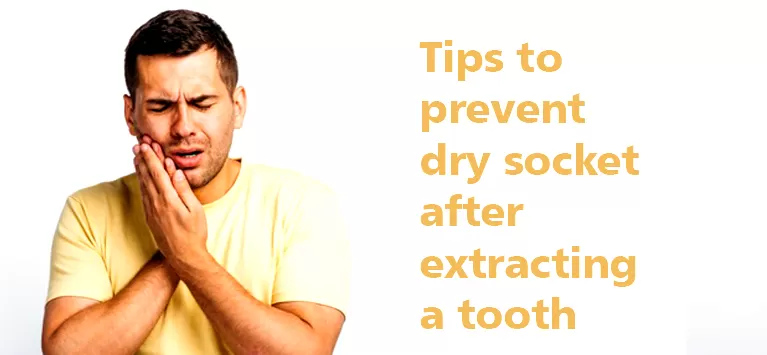How To Prevent Dry Socket
One way to prevent dry sockets is to avoid smoking or using tobacco products after tooth extraction. Nicotine can slow down the healing process and reduce blood flow, which increases the risk of developing dry sockets. Additionally, eating soft foods and avoiding hard or crunchy foods can help prevent dry sockets since these types of food tend to dislodge the blood clot that forms in the Socket of Wernicke.
Another helpful tip for preventing dry sockets is carefully following your dentist’s post-operative instructions. It includes refraining from spitting or rinsing vigorously for at least 24 hours after the extraction and avoiding strenuous physical activity for a few days afterward. Your dentist may also recommend using an antibacterial mouthwash or topical ointment to help reduce inflammation and promote healing.
In summary, you are taking care of your oral health after a tooth extraction is crucial in preventing dry sockets. By avoiding smoking or tobacco use, eating soft foods, following post-operative instructions closely, and practicing good oral hygiene, you can significantly reduce your risk of experiencing this painful condition.
How to treat dry socket
A dry socket is a painful dental condition when a blood clot in the extraction site dissolves or dislodges before the wound has healed. It can lead to severe pain, bad breath, and infection. Fortunately, there are several things you can do to prevent dry sockets.
Firstly, avoid smoking for at least 48 hours after your tooth extraction. Smoking can delay healing and increase the risk of developing dry sockets. Also, avoid drinking through a straw or spitting forcefully as these actions can dislodge the blood clot.
Keeping good oral hygiene is also crucial in preventing dry sockets. Brush your teeth gently and avoid touching the extraction site with your toothbrush bristles. Rinsing your mouth with warm saltwater after meals can promote healing and reduce inflammation.
Finally, follow all post-operative instructions your dentist provides carefully to ensure proper extraction site healing. With proper care and attention, you can minimize your chances of developing dry sockets and return to normal activities sooner rather than later!
How long does the dry socket last
A dry socket is one of the most common complications after tooth extraction. This severe condition occurs when the blood clot that forms at the extraction site becomes dislodged or dissolves. When this happens, the underlying bone and nerves are exposed to air, food particles, and fluids, causing intense pain and discomfort. A dry socket can take 5 to 7 days to heal.
While dry sockets cannot always be prevented after a tooth extraction, there are some steps you can take to lower your risk of developing this painful condition. Some effective methods include practicing good oral hygiene by brushing regularly and using mouthwash as your dentist directs. Additionally, avoid smoking or using tobacco products for at least 24 hours after surgery, as it can delay healing and increase your risk of dry sockets.
It’s also important to follow all postoperative instructions your dentist provides closely. It includes avoiding excessive physical activity for at least 48 hours following surgery and eating soft foods like soup or mashed potatoes for a few days until you feel comfortable chewing again. By taking these simple precautions seriously, you can help minimize your chances of experiencing the unpleasant symptoms of dry sockets after tooth extraction.
How can I avoid getting a dry socket after tooth extraction?
- Follow post-operative instructions: After tooth extraction, following the post-operative instructions given by your dentist or oral surgeon is crucial. These may include avoiding smoking or using straws, sticking to soft foods for a few days, and avoiding vigorous rinsing or spitting.
- Keep the blood clot intact: One of the leading causes of dry sockets is dislodging the blood clot that forms in the empty tooth socket after extraction. To prevent this from happening, avoid poking at the site with your tongue or fingers and refrain from brushing directly over it for a few days.
- Manage pain appropriately: If you experience pain after tooth extraction, take painkillers as prescribed by your dentist or oral surgeon instead of relying on over-the-counter medication. Overusing aspirin can thin your blood and increase the risk of developing dry sockets.
Following these simple steps can reduce your chances of developing a dry socket after tooth extraction. Remember that proper oral hygiene practices are key to preventing complications from dental procedures such as extractions.
What are the symptoms of dry sockets, and how long does it last?
A dry socket is a painful condition that can occur after tooth extraction. The symptoms of dry sockets include severe pain, bad breath, and an unpleasant taste in the mouth. The pain may be felt in the area of the extraction site and may also radiate to other parts of the face and neck.
A dry socket is caused by the absence of a blood clot that should form in the extraction site after a tooth is removed. Without this protective clot, bone and nerve endings are exposed, leading to pain and discomfort. If left untreated, a dry socket can last several days or even two weeks.
Preventing dry sockets involves taking certain precautions before and after tooth extraction surgery. Patients should avoid smoking, drinking alcohol or carbonated beverages, using straws, or rinsing their mouths vigorously for at least 24 hours following surgery. Additionally, it’s important to follow your dentist’s post-operative instructions closely to minimize your risk of developing this painful condition.
FAQs
What is a dry socket?
Dry socket is a painful complication after tooth extraction. It happens when the blood clot at the extraction site fails to form, dislodges, or dissolves before the wound fully recovers.
How can I prevent dry sockets?
You can take several steps to reduce your risk of developing a dry socket after tooth extraction. First and foremost, avoid smoking or using tobacco products for at least 48 hours after your procedure. Tobacco use has been linked to an increased risk of developing dry sockets. You should also avoid drinking through a straw, as sucking on anything can create suction inside your mouth and dislodge the blood clot.
What should I do if I think I have a dry socket?
If you experience severe pain following a tooth extraction, it’s important to contact your dentist or oral surgeon right away. They can examine your mouth and determine whether you have developed a dry socket. Treatment may involve flushing out the empty tooth socket with saline solution and packing it with medicated gauze to promote healing and reduce pain.










